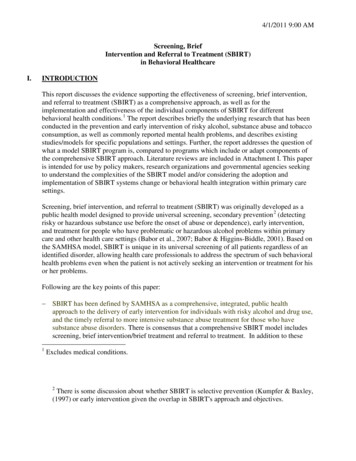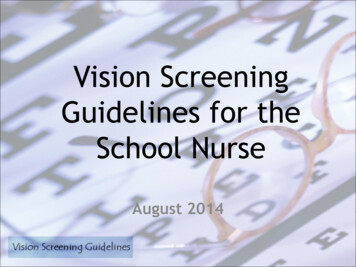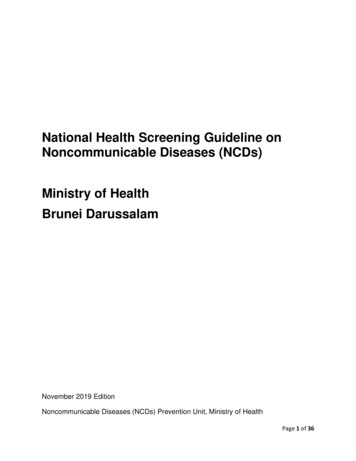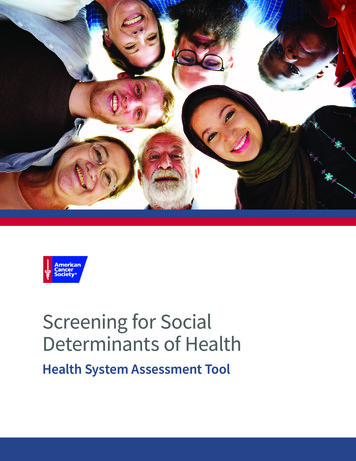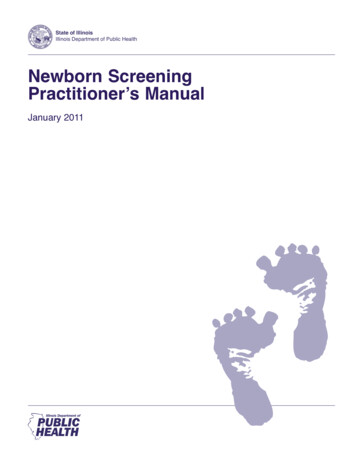
Transcription
Screening to Identify CommerciallySexually Exploited ChildrenA Guide for Implementing the Commercial Sexual Exploitation – Identification Tool(CSE-IT) in Youth-Serving OrganizationsWestCoast Children’s Clinic
Screening to Identify Commercially Sexually Exploited ChildrenPrincipal Author: Hannah Haley, MSWContributing Authors: Danna Basson, PhD; Jodie Langs, MSWRecommended CitationHaley, Basson, & Langs (2017). Screening to identify commercially sexually exploited children. Oakland, CA: WestCoastChildren’s Clinic. 2017 WestCoast Children’s ClinicWestCoast Children’s Clinic, located in Oakland, California, is a non-profit community psychology clinic that has provided mental health services to Bay Area children since 1979. Our mission is threefold: 1) to provide psychological services to vulnerable children, adolescents, and their families regardless of their ability to pay; 2) to train the next generation of mental health professionals; and 3) to conduct research to inform clinical practice and public policy.WestCoast Children’s Clinic addresses child sex trafficking by providing specialized mental health services to over 100sexually exploited youth each year. We also improve the systems that support all victims of sexual exploitation throughpolicy advocacy, community education, research, and training.WestCoast Children’s Clinic3301 E. 12th Street, Suite 259Oakland, CA 94601Phone: 510-269-9030Fax: 510-269-9031www.westcoastcc.orgFor more information about this guide or the Commercial Sexual Exploitation-Identification Tool, contactscreening@westcoastcc.org.2
ACKNOWLEDGEMENTSWe could not have completed the development, pilot, and validation of the CSE-IT without the steadfast support of ourfunders and partners. Our funders recognized the urgent need to understand the scope of child sex trafficking in our communities and provide professionals with tools to recognize the signs. Hundreds of individuals at dozens of organizationscommitted to identifying youth who are exploited and get them the help they need; all stepped up to prevent prolongedabuse for sexually exploited children.As the authors, we are indebted to members of our team for contributing wisdom from their extensive clinical and trainingexperience in the form of thoughtful input and feedback on the content of this guide – thank you Elise Geltman and AmaraBenjamin-Bullock. Lastly, we wish to thank our indomitable editor, Melinda Clemmons, for her careful eye.Thank you.Our Generous Funders:Fighting BackAlameda CountyHathaway-Sycamores Childand Family ServicesCalifornia Department of Social ServicesChabot Las Positas Community CollegeChild and Family PolicyInstitute of CaliforniaHedge Funds Care / Help forChildren FoundationJaMel PerkinsKaiser Permanente CommunityBenefit Northern CaliforniaPresent Purpose NetworkThe Quint Family TrustThe Walter S. Johnson FoundationThe Zellerbach Family FoundationCSE-IT Pilot Agency Partners:Bay Area Legal AidBay Area Youth CenterChildSafeChildren’s Law CenterChildren’s Receiving HomeCommunicare Health ServicesContra Costa CountyProbation DepartmentContra Costa County Employmentand Human Services DepartmentCorbett Group HomesCrittenton Services forChildren & FamiliesDreamcatcher Youth ShelterEmpower YoloKern County Department ofHuman ServicesLos Angeles Department ofChild and Family ServicesSan Diego County ChildWelfare ServicesSan Francisco County HumanServices AgencySan Joaquin County HumanServices AgencySan Joaquin Women’s CenterLos Angeles Departmentof Mental HealthSan Luis Obispo County ChildWelfare ServicesLarkin Street Youth ServicesSan Mateo County HumanServices AgencyLaw Foundation of Silicon ValleyMadera County Social ServicesMonterey County CommunityHuman ServicesMonterey County Office of EducationMonterey County Probation DepartmentMonterey County Family andChildren ServicesMulti-Disciplinary Interview CenterNoah’s AnchorageOperation SafehouseRiverside County Departmentof Public Social ServicesSacramento City Unified School DistrictSacramento County ProbationDepartmentSacramento County ChildProtective ServicesCommunity SolutionsSan Benito County ProbationDepartmentSan Benito County Health andHuman Services AgencySan Bernardino Child andFamily Services3Santa Barbara County Departmentof Mental HealthSanta Barbara County Departmentof Social ServicesSanta Clara County ProbationDepartmentMonarch ServicesSanta Cruz County ProbationDepartmentSanta Cruz County HumanServices DivisionSonoma County Department ofChild and Family Services(Valley of the Moon)Turning Point Community ProgramsUC Davis Medical CenterCAARE ProgramVentura County Department ofChild and Family ServicesYolo County Child Welfare ServicesYolo County Probation DepartmentYolo Family Service Agency
TABLE OF CONTENTSABSTRACT 5TERMINOLOGY USED IN THIS GUIDE 6ABOUT THE COMMERCIAL SEXUAL EXPLOITATION – IDENTIFICATION TOOL 7IMPLEMENTING THE CSE-IT TO IMPROVE EARLY IDENTIFICATION 8THE IMPORTANCE OF EARLY IDENTIFICATION 8UNIVERSAL SCREENING 8DEVELOPING A SCREENING AND RESPONSE PROTOCOL 81. AT WHAT SERVICE POINT(S) SHOULD STAFF CONDUCT SCREENING? 92. HOW WILL STAFF RESPOND TO YOUTH WHO HAVE INDICATORS OF TRAFFICKING? 93. HOW WILL STAFF DOCUMENT SCREENING RESULTS AND RESPONSE STEPS? 114. WHAT IS YOUR TRAINING AND TECHNICAL ASSISTANCE PLAN FOR STAFF AND LEADERSHIP? 11CONTINUALLY EVALUATE AND IMPROVE YOUR PROTOCOL 12CONCLUSION 12APPENDIX A: PILOT STUDY DEMOGRAPHICS 13APPENDIX B: CSE-IT FINAL INSTRUMENT 144
ABSTRACTThis guide provides recommendations for implementing the Commercial Sexual Exploitation–Identification Tool (CSE-IT)to improve early identification of commercially sexually exploited children. The CSE-IT is an evidence-based screeningtool designed for use in multiple child-serving systems, including child welfare, juvenile justice, schools, residential, mentalhealth, medical, and homeless services. The CSE-IT is used as part of a universal screening approach to systematicallyidentify the presence of indicators of child sex trafficking. All youth ages 10 and over should be screened, regardless ofgender, ethnicity, culture, sexual orientation, residence, health, socioeconomic status, appearance, or behavior.Organization leaders should develop a protocol to provide clear guidance to staff on how to conduct screening and respond to youth who have indicators of trafficking, and what documentation and reporting are required. Ultimately, screening helps agencies and systems identify youth earlier, and provides data that allows them to target resources to preventprolonged exposure to exploitation.5
TERMINOLOGY USED IN THIS GUIDEIn this guide, we use the terms “commercial sexual exploitation of children” and “child sex trafficking” interchangeably.We also use the terms “exploitation” and “trafficking” in some instances for brevity. Within the context of this guide, thoseterms refer to “commercial sexual exploitation” and “sex trafficking.”The federal Trafficking Victims Protection Act of 2000 defines sex trafficking as “the recruitment, harboring, transportation,provision, or obtaining of a person for the purpose of a commercial sex act” (18 U.S.C. Section 1591). Under this statute,individuals under the age of 18 are considered victims of human trafficking regardless of the use of force, fraud, or coercionto induce the act. While definitions of commercial sexual exploitation vary, for the purposes of this guide, the broadestdefinition applies: Commercial sexual exploitation is the exchange of a sex act or sexually explicit imagery for money ornon-monetary goods.6
ABOUT THE COMMERCIAL SEXUALEXPLOITATION – IDENTIFICATION TOOLIn 2014, WestCoast Children’s Clinic developed the Commercial Sexual Exploitation – Identification Tool (CSE-IT – pronounced “see it”) with input from over 100 survivors and service providers. Designed for use by staff with a variety ofprofessional backgrounds, the CSE-IT is used in multiple settings, including mental health, child welfare, juvenile justice,schools, residential programs, and homeless youth shelters.To ensure that it accurately identifies youth who have clear indicators of exploitation, we validated the CSE-IT. We workedcollaboratively with 56 agencies in 22 California counties and San Antonio, Texas, to pilot the CSE-IT over 15 months. Aspart of this effort, we trained 2,000 service providers in these 56 agencies to recognize the signs of exploitation. Providersscreened 5,537 youth and identified 635 youth with clear indicators of trafficking.We revised the CSE-IT based on the results of the validation, and are implementing the CSE-IT 2.0 with new and existingpartners. As we gather more data, we will continue to evaluate and improve the tool. The recommendations in this guidewill support agencies in implementing the CSE-IT 2.0 to screen youth for commercial sexual exploitation.In addition to the CSE-IT, WestCoast developed the CSE-IT: Hotline and Intake (CSE-IT: H&I), which is designed for childprotective services staff to screen child abuse reports for indicators of trafficking.To download a copy of the CSE-IT or learn more about other versions of the tool, visit www.westcoastcc.org/cse-it.7
IMPLEMENTING THECSE-IT TO IMPROVEEARLY IDENTIFICATIONyouth at risk of suicide and in medical settings to detect incipient diseases. As the first step in recognizing early signs,universal screening is used to facilitate early interventionand prevent complications. This approach is necessary toidentify exploited youth early and prevent prolonged abuse.The Commercial Sexual Exploitation-Identification Tool(CSE-IT) meets the urgent need for a validated screeningtool to identify children with indicators of sex trafficking.Recent federal laws define child sex trafficking as a form ofchild abuse and neglect and require states to identify andserve sexually exploited youth. This guide provides recommendations for developing and implementing a screeningand response protocol using the CSE-IT to improve earlyidentification of commercially sexually exploited children.The CSE-IT is designed to be universally implemented tolook for signs of trafficking among all youth who meet predetermined criteria. Youth ages 10 and over should bescreened, regardless of gender, ethnicity, culture, sexualorientation, residence, health, socioeconomic status, appearance, or behavior. In addition to youth who fit this agecriteria, it is important to screen youth outside the recommended age range if there are signs they may be exploitedor are at risk of exploitation for any reason.The Importance Of Early IdentificationCommercial sexual exploitation impactsyoung people beyond their 18th birthdays. TheCSE-IT is appropriate for identifying children,youth, and young adults who are in need of supportto address the trauma of being exploited.Commercial sexual exploitation of children is a form ofviolence resulting in complex developmental trauma withsevere and long-term consequences on physical andmental health, cognitive abilities, and behavior. Exposureto this form of ongoing trauma in childhood and adolescence impacts critical stages of development. Interveningquickly is imperative, and doing so earlier in the cycle ofexploitation can reduce the impact of trauma on children’sdevelopment.Screening differs from assessment, which is a comprehensive evaluation of a youth’s strengths, needs, and experiences used to inform treatment or other interventions.Screening is the first step in identifying youth with indicators of trafficking, and should be followed by a comprehensive assessment to understand the full scope of a youth’sneeds and circumstances.Though recognized as a child welfare, mental health, andpublic health crisis, commercial sexual exploitation of children remains hidden. And despite the growing awarenessof the problem, it is poorly understood and difficult to recognize. As a result, 75 percent of young people who experience commercial sexual exploitation endure multiple yearsof abuse before anyone intervenes.It is important to note that screening is notdiagnostic. Rather, it is a preliminary step thatprompts additional information gathering andinterventions if problems or concerns are identified.To improve the timeliness of intervention, service providers must systematically look for signs of trafficking amongall vulnerable youth. Providers need an evidence-basedscreening tool, like the CSE-IT, and clear protocols on howto use it and how to respond to exploitation appropriately,given the provider’s role in the children’s system of care.Universal ScreeningDEVELOPING ASCREENING ANDRESPONSE PROTOCOLUniversal screening is used in various settings to identifyindividuals who need further evaluation or intervention.For example, it is used in mental health settings to identifyDeveloping a screening and response protocol is a process involving key members of your organization, includingany person with subject matter expertise and knowledge8
of community resources. The goal of this process is toprovide clear guidance to staff on how to screen for andrespond to indicators of trafficking. Carefully consider thefollowing questions to guide development of a comprehensive protocol:in some cases the staff position responsible for completingthe CSE-IT is determined by the intake process and programstructure, such as in agencies with centralized intake staffwho conduct all screening before case assignment. In otherprograms, all staff may be responsible for completing theCSE-IT for each of their assigned clients. Programs that usea team to provide services (such as wraparound) should consider completing the CSE-IT collaboratively, as each teammember will have different information about the youth.1. At what service point(s) should staff conductscreening?1. What is your response protocol for youth who haveindicators of trafficking?Length of Service2. How will staff document results of screening andresponse steps?Your program’s length of service is another important factorto consider when determining how soon to complete theinitial screening. Base this timeframe on when the responsible staff position will have adequate information to complete the tool, erring on the earlier side whenever possible.Short-term programs that work with youth for 30 days orless may decide to screen youth only once, within threedays of first contact. Programs with a six-months servicelimit may consider an initial screening within two to threeweeks of intake, and a final screening before the youthtransitions out of the program in order to make appropriate referrals. At the latest, we recommend completing theinitial screening within 30 days of intake so that the resultscan inform your assessment and case plan. Long-term programs should also screen youth every six months, whichis consistent with existing assessment and documentationrequirements in most public settings.3. What is your training and technical assistance plan?LESSONS FROM THE FIELD:Our agency covers a big geographic area, so we decidedto phase in implementation one area at a time. Wewrote into our screening protocol a timeline of when wewould start using the CSE-IT in each region.– Charisma De Los Reyes, PolicyAnalyst, San Diego County1. At what service point(s) shouldstaff conduct screening?Youth should be screened within 30 days of intake and every six months, and each agency should customize theseguidelines based on their staffing structure and length ofservice(s). Document in your protocol each service pointwhen screening should occur, and the staff position that isexpected to complete the CSE-IT and document the results.For youth who turn 10 while being servedin your agency, conduct the first screeningwithin 30 days of their 10th birthday.Youth should be re-screened every six monthsregardless of any previous score on the CSE-IT inorder to evaluate the youth’s current circumstances.This includes re-screening youth who previouslyreceived a score of “Clear Concern” to ensurethe staff person working with the youth has aclear sense of the youth’s current needs.2. How will staff respond to youthwho have indicators of trafficking?Screening is only the first step. Once youth with indicatorsof trafficking are identified, staff need to know what to donext. Each agency implementing the CSE-IT should determine appropriate follow-up steps including, at a minimum,the following:Staffing StructureMandated Child Abuse Report:Most agencies find it more effective for the person assigned towork with the youth to conduct the initial screening. However,Effective May 29, 2017, the Justice for Victims of Trafficking Act of 2015 amended the federal definition of “child9
abuse” to include commercial sexual exploitation. Childsex trafficking is considered child abuse under federal lawand must be reported to local law enforcement or childwelfare agencies. The score on the CSE-IT along with otherinformation known to the provider should be taken into account to determine if there is reasonable suspicion thatchild abuse has occurred.to completing formal assessment tools on a routine basis,staff working with youth should monitor areas of greatestconcern to be able to respond to new information or emerging issues. Some assessment tools incorporate informationabout sexual exploitation. Others are specific to sexual exploitation, such as the Child and Adolescent Needs andStrengths – Commercial Sexual Exploitation (CANS-CSE).Each agency should determine if the tool they currently useadequately assesses the needs of youth with indicators oftrafficking or if a targeted instrument is needed.Youth with indicators of trafficking are those whosescore on the CSE-IT falls within the categories“Clear Concern” or “Possible Concern.” The responsemay vary based on a full assessment of the youth’sneeds and circumstances, and should be discussedbetween the worker and their supervisor.LESSONS FROM THE FIELDOur county has a steering committee that developedan interagency protocol for responding to victims ofsex trafficking. Our protocol tells us what each agencyshould do after identifying exploited youth, and how tocoordinate services for minors who are victimsof trafficking.– Michelle Callejas, Deputy Director ChildProtective Services, Sacramento CountySafety Planning:A youth’s ability to access services may be impeded bymultiple factors, such as ongoing control by an exploiter,distrust of providers, or lack of transportation. As a result,some youth may engage in services intermittently or continue to be exploited while receiving services. To addressongoing risk of harm, safety planning is a central part of atrauma-informed approach to working with exploited youth.Referrals to Community-Based Services:Exploited youth often have multiple needs requiring coordinated service delivery from several providers. Dependingon the youth’s current circumstances, level of concern onthe CSE-IT, or needs determined by assessment, providersshould make referrals to other services, including:Safety planning involves ongoing discussion with youthabout how to recognize dangerous situations and resources they can access to attend to their basic needs,health, and safety. This includes: A discussion about calling 911 during emergencies thatthreaten the youth’s physical safety. 911 is the only numberthat can be called from cell phones that are disconnectedfrom service;Crisis response from a provider specializingin crisis counseling for survivors of sexualexploitation, sexual assault, or domestic violence; Resources for basic needs such as food, clothing,and personal or baby care supplies;Phone numbers for crisis lines, such as the Crisis Text Line, National Human Trafficking Hotline , or local sexual assault or domestic violence hotlines ; Medical services to address physical andreproductive health care needs; CSEC-specific advocacy and case managementto address needs resulting from exploitation andassist youth in accessing benefits and services; Contact information for a service provider or otheradult the youth feels safe reaching out to; and Locations and hours of emergency shelters, foodassistance programs, and crisis medical clinics.Trauma-informed therapy to address mental healthneeds; Housing or residential services; Legal services for youth who have been chargedwith a crime or who choose to press charges ortestify against their exploiter. Many exploited youthare entitled to other benefits, which legal advocacycan help them access;Comprehensive Assessment:Screening should always be followed by a full assessmentof the youth’s needs and strengths to guide treatment planning and determine appropriate interventions. In addition10
Victim witness advocacy and protection for youthparticipating in prosecution of their trafficker, oftenavailable through courts, district attorneys’ offices,or law enforcement agencies.adequately respond to the needs of clients who aresexually exploited.Each agency should develop procedures to monitor thisinformation. Leadership should regularly review data andreports and ensure that oversight is built into the organization’s quality assurance review process. Supervisorsshould also work with staff to reinforce expectations anddiscuss challenges that surface while using the tool.Research the programs in your area and make a list ofagencies that provide services to exploited youth. Thoughnot all communities have CSEC-specific services, considerreferral to agencies that provide trauma-informed services.It is also important to determine which agencies have confidential locations where youth can access services orhousing without fear of being located by their trafficker orothers who pose a danger to their well-being.4. What is your training and technicalassistance plan for staff and leadership?Consultation:Staff are frequently unsure what steps to take after identifying that their client is exploited. Additionally, effective en-When selecting trainers, consider their abilityto address implicit bias related to genderidentity and expression, sexuality, race,ethnicity, and socio-economic status, andits impact on sexually exploited youth.gagement can be challenging, particularly with youth whoare intermittently engaged in services. Providing opportunities for regular case consultation is critical to support staff.When in-house knowledge of how to work with exploitedyouth is limited, we recommend consulting with external organizations that have expertise in serving trafficked youth.Consultation with survivor advocates in particular buildsstaff capacity to provide a trauma-informed response.Training and technical assistance are critical to effectivelyimplement the CSE-IT. Initial and ongoing training buildstaff’s ability to recognize the signs of trafficking and workwith exploited youth. Technical assistance provides an opportunity to troubleshoot challenges and build a more nuanced understanding of screening in complex situations.Create a comprehensive training and technical assistanceplan that includes the following topics:LESSONS FROM THE FIELDOur staff felt more confident using the CSE-IT after wewalked through their first completed CSE-IT togetherin supervision. Now we use this approach in our teammeetings, and staff support each other in gettingfamiliar with the indicators on the CSE-IT andhow to score it.– Child Welfare Supervisor, San Francisco County, CA1. Technical assistance for leadership and management to develop and implement the screening andresponse protocol, build staff buy-in, and establishan accountability process.2. A 3-hour in-person user training to use the CSE-IT(required for each user). This initial training establishes foundational knowledge of key indicators ofexploitation, how to use the screening tool, andhow to engage youth in a conversation about exploitation.3. How will staff document screeningresults and response steps?The protocol should include requirements for documentingscreening results and follow-up actions. Leadership maywant to review documentation and aggregate reports on aregular basis for several reasons: To monitor if staff are meeting expectations toscreen and respond to sexual exploitation; To understand the number of trafficked youthserved by their agency; and To determine if additional resources are needed to3. Technical assistance for staff to troubleshoot questions or challenges that arise during screening.4. Training for supervisors and managers to build theircapacity to support staff in identifying and servingsexually exploited youth.5. Additional training for staff to deepen their under-11
standing of exploitation and how to work with youthwho are exploited.6. Train-the-Trainer to sustain capacity within organizations to train new staff on the CSE-IT. WestCoastoffers Train-the-Trainer to organizations that havebeen using the CSE-IT for 6 months or longer.7. Orientation training on commercial sexual exploitation and the CSE-IT for new staff.Continually Evaluate AndImprove Your ProtocolThe screening and response protocol should be modifiedas needed based on gaps or training needs identified bythe body responsible for oversight. Use documentationand feedback from staff, supervisors, and managers to assess protocol implementation. Regularly review the questions in this guide and consider how your protocol can beimproved.CONCLUSIONDeveloping and implementing a routine screening and response protocol to identify children who have been sexually exploited improves early identification and reduces prolonged abuse. Clear guidance for staff supports their abilityto work effectively with sexually exploited clients. Programleadership can use screening results and aggregate data tounderstand the needs of clients, guide resource allocation,and provide appropriate staff training. Ultimately, screeninghelps agencies and systems identify youth earlier, and provides data that allows them to target resources to preventprolonged exposure to exploitation.12
APPENDIX APilot Study DemographicsIn 2014, WestCoast Children’s Clinic developed the Commercial Sexual Exploitation – Identification Tool (CSE-IT) withthe input of over 100 survivors and service providers. We validated the CSE-IT to ensure that it accurately identifies youthwho have clear indicators of exploitation. We worked collaboratively with 56 agencies in 22 California counties and SanAntonio, Texas to pilot the CSE-IT. As part of this effort, wetrained 2,000 service providers to recognize the signs of exploitation. Providers screened over 5,000 youth and identified635 youth with clear indicators of exploitation.‘Clear Concern’by GenderExpressionCisgenderNumberPercent620 out of 547711.3%15 out of 6025%Transgender‘Clear Concern’ by YouthRacial and/or EthnicIdentityNumberPercent10 out of 1536.54%Black or African-American282 out of1,80615.61%Hispanic or Latino142 out of1,9087.44%65 out of 35018.57%Native American1 out of 352.86%113 out of1,04510.81%22 out of 2409.17%AsianPlease keep in mind that these data cannot be generalized to the broader population, and represent demographics of youth in the agencies that participated in the pilot.These charts show demographics of youth screened during the pilot. For more information about the CSE-IT, including a full report regarding the validation study, visitwww.westcoastcc.org/CSE-ITMultiple RacesNumber of youth with:Clear Concern635(11.5%)White or CaucasianPossible Concern1,029(18.6%)Another Race or EthnicityNo Concern3,873(69.9%)TOTAL youth age 10 screened5,537(100%)Clear Concern’ by YouthGender IdentityAge 0-11 years319(90.11%)29(8.19%)6(1.69%)35412-13 years463(80.38%)76(13.19%)37(6.42%)576(2 year increments)NumberPercentFemale557 out of2,68120.78%14-15 years935(69.57%)273(20.31%)136(10.12%)1,344Male71 out of2,8252.51%16-17 years1,527(68.23%)435(19.44%)276(12.33%)2,2387 out of 3122.58%18-19 years451(61.87%)158(21.67%)120(16.46%)72920-21 years166(63.60%)52(19.92%)43(16.48%)261Youth whose gender isunknown, or not male or female13
APPENDIX B:CSE-IT Final InstrumentWestCoast Children’s ClinicCommercial Sexual Exploitation-Identification Tool (CSE-IT) – version 2.01. HOUSING AND CAREGIVING. The youth experiences housingor caregiving instability for any oncerna. Youth runs away or frequently leaves their residence for extended periods oftime (overnight, days, weeks).0012b. Youth experiences unstable housing, including multiple foster/group homeplacements.0012c. Youth experiences periods of homelessness, e.g. living on the street or couchsurfing.0012d. Youth relies on emergency or temporary resources to meet basic needs, e.g.hygiene, shelter, food, medical care.0012e. Parent/caregiver is unable to provide adequate supervision.0012f. Youth has highly irregular school attendance, including frequent or prolongedtardiness or absences.0012g. Youth has current or past involvement with the child welfare a. Youth has been sexually abused.0012b. Youth has been physically abused.0012c. Youth has been emotionally abused.0012d. Youth has witnessed domestic rn2Indicator 1 Score: A
Benjamin-Bullock. Lastly, we wish to thank our indomitable editor, Melinda Clemmons, for her careful eye. Thank you. Our Generous Funders: Alameda County California Department of Social Services Chabot Las Positas Community College . UC Davis Medical Center CAARE Program Ventura County Department of Child and Family Services Yolo County Child .




